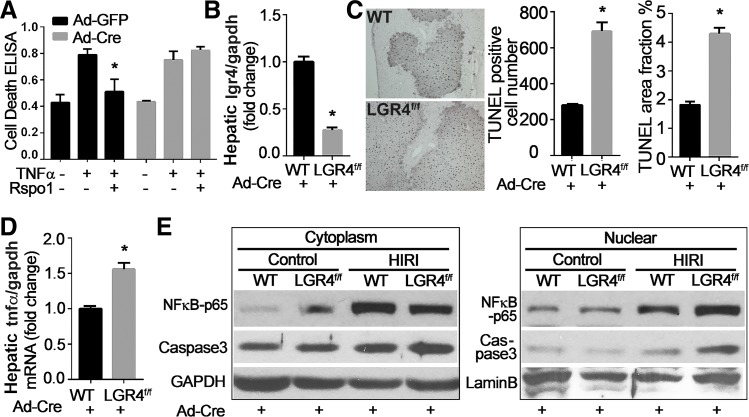Fig. 4.
Knockdown of leucine-rich repeat G protein-coupled receptor 4 (LGR4) by adenovirus renders hepatocytes more vulnerable to injury. A: LGR4flox/flox hepatocytes treated with Cre adenovirus (Ad-Cre) are more vulnerable to tumor necrosis factor-α (TNFα)-induced injury. Hepatocytes isolated from LGR4flox/flox mice were treated with adenovirus with green fluorescent protein (Ad-GFP) or Cre (Ad-Cre) for 24 h and then exposed to TNFα (100 ng/ml) with or without R-spondin1 (Rspo1, 200ng/ml) for an additional 12 h. Cell damage was measured by ELISA. *P < 0.05 vs. TNFα. B–E: LGR4flox/flox mice treated with Ad-Cre are more vulnerable to hepatic ischemia/reperfusion injury. Twelve-week-old LGR4flox/flox mice and wild-type littermates (WT) were administered with Ad-Cre (109 pfu/mouse) via tail vein injection. One week later, mice were challenged with hepatic ischemia/reperfusion injury (HIRI). Hepatic mRNA levels of LGR4 validated knockdown of LGR4 in liver (B). Liver injury was evaluated by in situ cell death assay (TUNEL; C). TUNEL-positive cell numbers and staining area were calculated with ImageJ software and expressed as means ± SE; n = 8 for each group. *P < 0.05 vs. WT + Ad-Cre. D and E: LGR4 knockout renders NF-κB pathway highly activated. Hepatic RNAs were extracted and used for quantitative RT-PCR to detect the expression of TNFα (D). Liver proteins were separated into cytoplasmic and nuclear fractions and analyzed by Western blot analysis. GAPDH and lamin B were used as internal control for cytoplasmic and nuclear proteins, respectively (E). *P < 0.05 vs. WT + Ad-Cre.

